I have written about stoplights before, the red, green and sometimes yellow type, especially former mounting designs whose examples I found around town in the 1990s when I began compiling this website. One variety I haven’t paid attention to are blinking or continuously lit warning or caution lights. These can be found in “cyclops” form either midblock or mounted at intersections where a regular red-yellow-green light isn’t warranted by traffic volume.
Today however I am writing about a specific subgenre of stoplights: caution lamps that are mounted at full stops where traffic must turn left or right, and caution lamps that signal a bend in the road. I don’t think the Department of Transportation has mandated a specific design but, in general, it seems that one has been settled on.
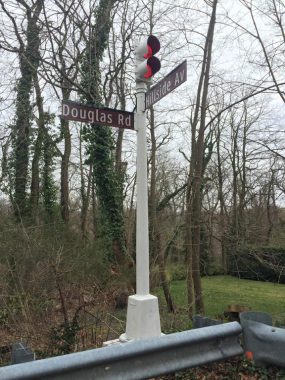
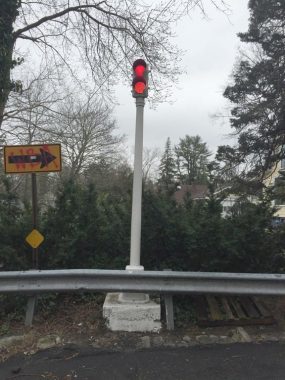
This pair can be found at Douglas Road and Hillside Avenue in Douglaston, adjoining Aurora Pond. The one on the left is unique in that a pair of street signs are mounted on it; few regular stoplights pull that kind of double duty.
Notice that while the pair of unblinking red signals are mounted on the same type of cylindrical posts that are used by many stoploghts and pedestrian control signals, the posts are painted white. This is a frequent feature on caution signals around town. In Douglaston, on Shore Road facing Little Neck Bay, the cross street end there are a number of similar poles to be found there.
Unblinking red is not universal. You’ll find blinking red and yellow combos, or cyclops red or cyclops yellow. I haven’t deciphered an intentional difference between the two.
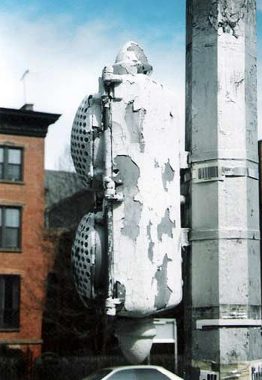
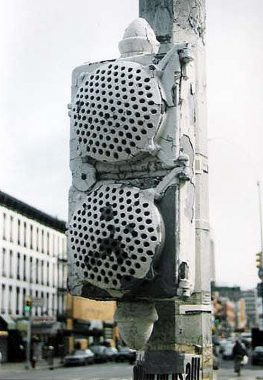
This caution signal was mounted facing the eastbound lane of West 125th Street where the street makes an eastern bend at Morningside Avenue. It illustrates another occasional feature: it’s behind a metal cage. When the signals are mounted low on a post within reach of pedestrians, the local youth’s habit is to destroy the glass mounting, so the DOT took pains to install shields like this.
Also notice that this was one of the last Ruleta signals still on the job in NYC. Those were the red and green lamps mounted on “olive” posts catercorner on intersections. Most were swapped out for other designs by the mid-1980s. Today most stoplights found at intersections are made by Marbleite.
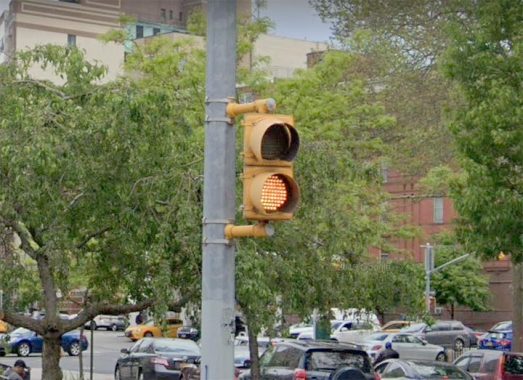
The Ruleta was replaced by this blinking yellow two-lamper.
Check out the ForgottenBook, take a look at the gift shop, and as always, “comment…as you see fit.”
3/21/20

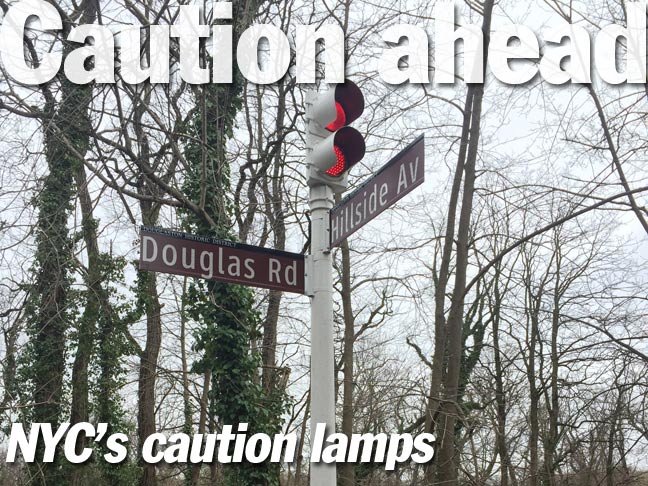
13 comments
There used to be a cyclops blinking red light at the intersection of Vernon Boulevard and 31st Ave. It was placed
there after the pier was demolished that extended the avenue out into the east river. Outside Boulevard Garden apartments there is a hanging two way quad cyclops red blinker at the intersection of 30th Ave. and 57th. St.
I didn’t realize that Queens has two Hillside Avenues. I finally found it on Google maps.
There are still some along Ditmars Blvd. as it parallels Grand Central Parkway.
Wow- new heights in esoterica – I love it! As a kid I was inexplicably fascinated by these also! My “home” version of this was a caged number at the end of Malba Drive in Queens. Alas, google street view tells me this one is no longer in place – bummer!
The most curious stoplight I’ve encountered is at the dead-end intersection of 119th St. and 20th Ave. in College Point. It’s such a sleepy little corner of Queens. In front of the stoplight, apparently there to prevent cars from driving into Flushing Bay, are usually parked cars and dumpsters, backed by a dilapidated chain-link fence.
Meanwhile 22nd Avenue, the next block south, has a very low one, shorter than me.
Holy smokes, you’re right (not that I had doubts), and it’s so low that I honestly never noticed it. Perhaps I never bothered to walk down that dead end, which is rather plain compared to 20th Ave.
As a kid I found the caged dead end lamps mysterious for some reason. The ones I am familiar with were on streets interrupted by the Bay Ridge Division of the LIRR. I note that at least some of them have been replaced by LEDs. Funny that the caged lamps actually looked something like a modern LED array with the individual LEDs visible.
If you have looked at those tax photos from the 1940’s, you can see why these warning lights were essential. Many intersections were lit by a single street light with a radial wave reflector and a low wattage incandescent bulb. It was pitch black in most areas. These warning lights were the only item that kept many vehicles from going into the water. Notice there were two red lamps to insure that there was one burning should a bulb burn out.
These were not the only warning lights used. It was a policy to provide a light at bridge abutments or columns mounted in the roadways. The Triborough Bridge abutments at 30th street in Astoria had lights recessed into the concrete. The north abutment light is gone, but the original south abutment light has been replaced with a single standard traffic signal light. Columns of bridges over the GCP were provided with a single warning light.
The forest of el columns at Astoria Blvd., Hoyt avenue and 31st street were provided with warning lights facing the direction of
traffic. There is an el column north of the intersection of Newtown Avenue and 31st Street that is positioned in the roadway of 31st street. This had a warning light fed from the 30th Avenue station.
Up until about 30 years ago, traffic light poles that were located in the middle of intersections had three or four flashing lights mounted on the base of the pole. They were replaced by reflector strips.
With the increased street lighting levels first from the 1947 Ten Year Plan, then the Mercury relighting plan, and finally the High Pressure Sodium relighting plan, all of these warning lights were unneeded, or so the City planners thought.
Several years ago, a car came barreling down 19th Avenue in Astoria. With no warning light or guardrail, the car went into the creek where the occupants drowned.
By the way, the “cyclops” next to Boulevard Gardens has been replaced by an “Accessable Pedestrian Signal” standard traffic light installation.
The caged signal was designed for another possible reason besides as an anti vandal measure. One thing that happens with signal lights is that without a hood the glass front will eventually accumulate a coating of grime that will eventually block the light. So nearly all signal lamps have a hood. By putting a thick shield with holes to let the light thru over the glass, besides protecting from grime, you can reduce the angles the light can be seen from. So in this case, if my memory is correct, the light is mounted near where 125th street makes a bend but the actual street continues straight as Hancock Place. So the installers wanted a light that was only seen by the drivers and not illuminating the entire block 24 hours a day. Or causing confusing with other drivers.
They have these double red lights in Staten Island, on front near the bend onto Hylan Blvd.
Staten Island has had a number intersections with single indication cyclops (beacon) lights set up with the traditional yellow for main street, red for secondary street configuration.
They’re usually deployed at intersections where one or both streets meet at sharp curves. Other locations have double yellow warning signals to warn of sharp curves. All the beacons are 12 inch signals. In other areas the DOT used to have 8 inch double yellow signals to warn of sharp curves. Over the last 10-15 the 8 inch double yellows have been replaced with 12 inch heads and the DOT has been on crash course installing more of them along the more winding stretches of Amboy and Arthur Kill Rds as traffic volumes increased, Intrerestingly enough there is still an 8 inch double yellow signal right on Clove Rd near the Grasmere station.